Market Size of Workflow Automation Industry

| Study Period | 2019 - 2029 |
| Market Size (2024) | USD 21.70 Billion |
| Market Size (2029) | USD 34.18 Billion |
| CAGR (2024 - 2029) | 9.52 % |
| Fastest Growing Market | Asia-Pacific |
| Largest Market | North America |
Major Players
*Disclaimer: Major Players sorted in no particular order |
Workflow Automation Market Analysis
The Workflow Automation Market size is estimated at USD 21.70 billion in 2024, and is expected to reach USD 34.18 billion by 2029, growing at a CAGR of 9.52% during the forecast period (2024-2029).
The workflow concept has evolved from the notion of process in manufacturing and the office, and such processes have existed since the time of industrialization and are the outcome of a search to surge efficiency by concentrating on the routine aspects of work activities. They typically separate work activities into well-defined tasks, rules, roles, and procedures that regulate most of the manufacturing and office work. Initially, processes were carried out entirely by humans who manipulated physical objects.
- With the introduction of information technology, processes in the workplace are partially or totally automated by information systems through computer programs performing tasks and enforcing rules that humans previously implemented. Workflow automation is developed to enhance productivity and quality by incorporating best practices in workflow processes involved in manufacturing as well as management. It facilitates defining workflow processes from the data fetched from the data sources and the network location of the various stages at which the execution of that particular stage is performed, along with the generation of job ticket. The system is able to move the job ticket automatically without any intervention of any external factor along with providing the user, a visual display of status of any job ticket at any point of time. The system is also adaptable to changes at a particular stage.
- The growing demand for workflow software from organizations is leading to rapid investment in the development of more sophisticated and efficient software. According to Signavio, 62% of the organizations have modeled up to 25% of their businesses, but a meager 2% have all their processes modeled. Moreover, 13% of the surveyed organizations say that they are implementing intelligent automation solutions at scale; 23% are implementing, and 37% are piloting automation.
- The increasing demand for workflow software by organizations is leading to rapid investment in the development of more sophisticated and efficient software. There is increasing adoption of artificial intelligence and related new technologies ranging from computer vision, cognitive automation, and machine learning to robotic process automation. This convergence of technologies produces automation capabilities that dramatically elevate business value and competitive advantages for customers.
- Unlike any new technology implementation, workflow automation can create risks for cyberattacks directed at both human and non-human accounts. As a result, process automation security is of critical importance. RPA bots often work on confidential data, transferring it from one system to another. If data is not protected, it can be leveraged, costing businesses millions.
- With the onset of COVID-19, the vulnerability of supply chains has been exposed. For most IT organizations, a fragile ecosystem includes providers of critical IT services. In addition, work-from-home mandates led the service providers to ensure that mission-critical enterprise customers have the necessary tools and technologies to enable the speed, security, quality, and overall efficacy of services provided.
Workflow Automation Industry Segmentation
Workflow automation tools allow a business function to automate repeatable tasks using a set of directives or workflows that form the basis of the operation. Over the last few years, the concept has evolved considerably with the emergence of RPA, BPM suites, Remote Desktop Automation, and custom scripting. The main objective is identifying repetitive tasks or any manual process that software, apps, or tech could handle better.
The workflow automation industry is segmented by solution (software and services), by end-user industry (banking, telecom, retail, manufacturing and logistics, healthcare and pharmaceuticals, energy and utilities, and other end-user industries), by deployment (cloud and on-premise), and by geography (North America, Europe, Asia-Pacific, and Rest of the World). The market sizes and forecasts are provided in terms of value (USD) for all the above segments.
| By Deployment | |
| On-premise | |
| Cloud |
| By Solution | |
| Software | |
| Service |
| By End-user Industry | |
| Banking | |
| Telecom | |
| Retail | |
| Manufacturing and Logistics | |
| Healthcare and Pharmaceuticals | |
| Energy and Utilities | |
| Other End-user Industries |
| By Geography | ||||||
| ||||||
| ||||||
| ||||||
| Rest of the World (Latin America, Middle East and Africa) |
Workflow Automation Market Size Summary
The workflow automation market is experiencing significant growth, driven by the increasing demand for software that enhances productivity and quality in both manufacturing and management processes. This market evolution is rooted in the historical need to improve efficiency by automating routine tasks, a concept that has been transformed with the advent of information technology. Today, workflow automation systems leverage advanced technologies such as artificial intelligence, machine learning, and robotic process automation to streamline operations, reduce manual intervention, and provide real-time visibility into processes. These systems are designed to adapt to changes and integrate seamlessly with existing data sources, offering features like customizable forms, templates, and conditional logic to optimize workflows. The adoption of IoT and the rise of low-code platforms further contribute to the market's expansion, making automation more accessible and reducing the burden on IT resources.
The market landscape is highly competitive, with major players like IBM, Oracle, Pegasystems, Xerox, and Appian Corporation leading the charge through strategic collaborations and technological innovations. These companies are focusing on enhancing their offerings with features that address security concerns, particularly in the context of cyber threats associated with automation. The COVID-19 pandemic has underscored the importance of robust automation solutions in maintaining operational efficiency amidst supply chain vulnerabilities. As organizations across various regions, including China, Japan, India, and Southeast Asia, embrace digital transformation, the demand for workflow automation software continues to rise. This trend is supported by initiatives aimed at improving data utilization, streamlining operations, and fostering innovation, which are crucial for maintaining competitive advantages in an increasingly digital world.
Workflow Automation Market Size - Table of Contents
-
1. MARKET DYNAMICS
-
1.1 Market Overview
-
1.2 Industry Attractiveness - Porter's Five Forces Analysis
-
1.2.1 Bargaining Power of Suppliers
-
1.2.2 Bargaining Power of Consumers
-
1.2.3 Threat of New Entrants
-
1.2.4 Intensity of Competitive Rivalry
-
1.2.5 Threat of Substitutes
-
-
1.3 Market Drivers
-
1.3.1 Increasing Adoption of IoT across industries
-
1.3.2 Rise in Implementation of RPA in Business Process Management
-
-
1.4 Market Restraints
-
1.4.1 Data Security Concerns
-
-
-
2. MARKET SEGMENTATION
-
2.1 By Deployment
-
2.1.1 On-premise
-
2.1.2 Cloud
-
-
2.2 By Solution
-
2.2.1 Software
-
2.2.2 Service
-
-
2.3 By End-user Industry
-
2.3.1 Banking
-
2.3.2 Telecom
-
2.3.3 Retail
-
2.3.4 Manufacturing and Logistics
-
2.3.5 Healthcare and Pharmaceuticals
-
2.3.6 Energy and Utilities
-
2.3.7 Other End-user Industries
-
-
2.4 By Geography
-
2.4.1 North America
-
2.4.1.1 United States
-
2.4.1.2 Canada
-
-
2.4.2 Europe
-
2.4.2.1 United Kingdom
-
2.4.2.2 Germany
-
2.4.2.3 France
-
2.4.2.4 Rest of Europe
-
-
2.4.3 Asia-Pacific
-
2.4.3.1 China
-
2.4.3.2 Japan
-
2.4.3.3 India
-
2.4.3.4 Rest of Asia-Pacific
-
-
2.4.4 Rest of the World (Latin America, Middle East and Africa)
-
-
Workflow Automation Market Size FAQs
How big is the Workflow Automation Market?
The Workflow Automation Market size is expected to reach USD 21.70 billion in 2024 and grow at a CAGR of 9.52% to reach USD 34.18 billion by 2029.
What is the current Workflow Automation Market size?
In 2024, the Workflow Automation Market size is expected to reach USD 21.70 billion.

